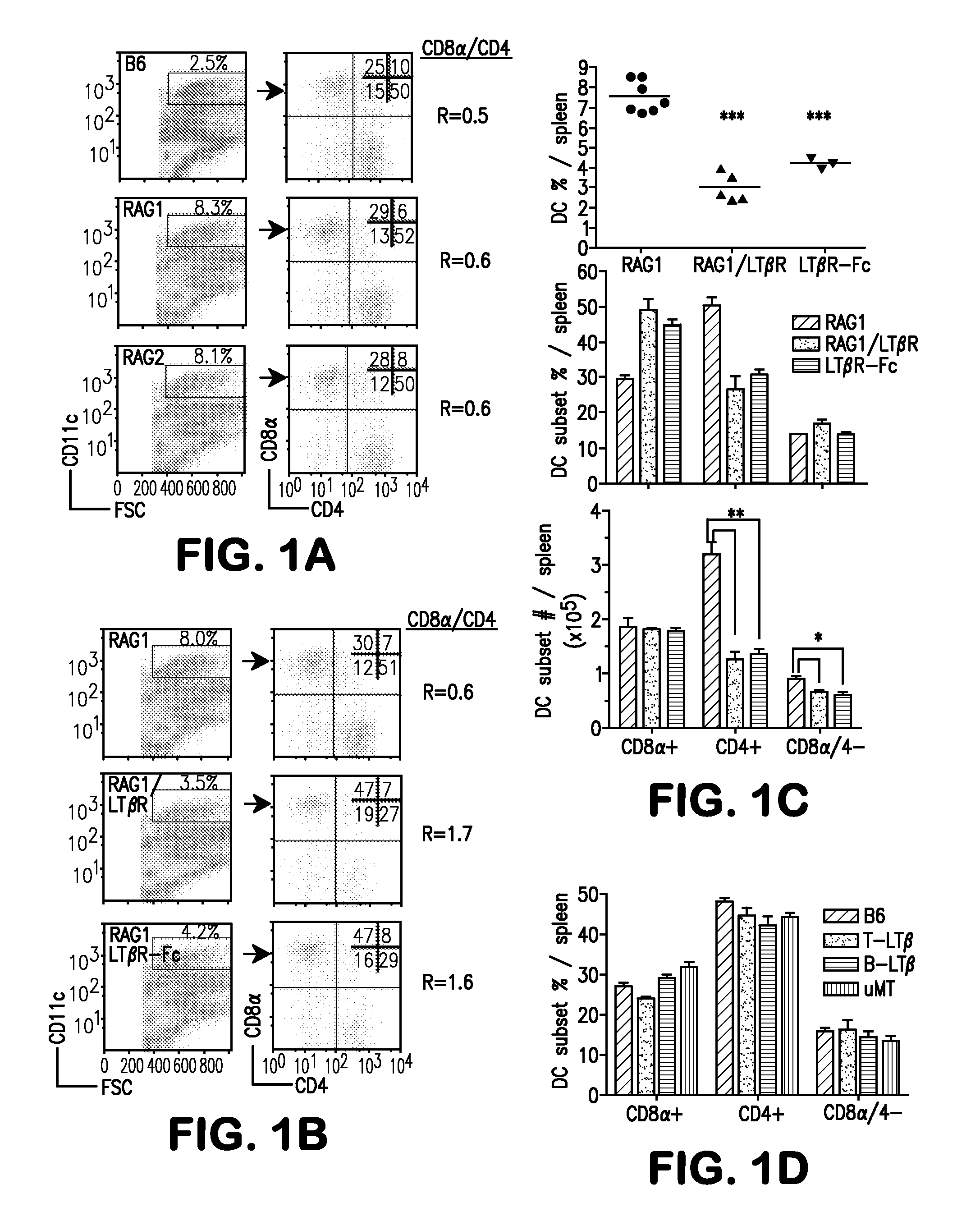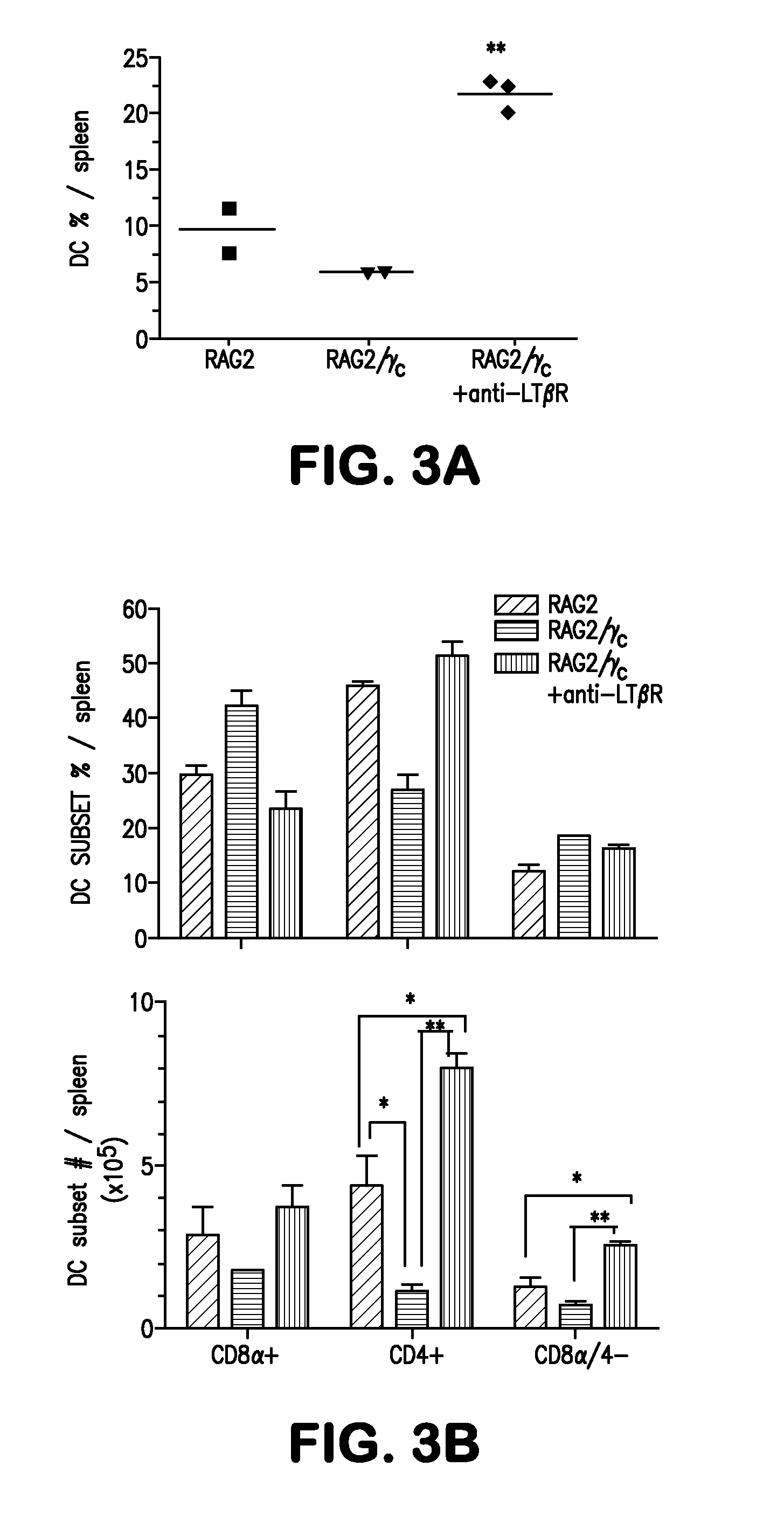Method for restoring dendritic cell populations
a dendritic cell and population technology, applied in the field of immunology, can solve the problems of poor transfer efficiency, limited attempts, and defects in stromal cells that cannot be corrected by bone marrow transfer, and achieve the effect of reducing dc population and restoring or increasing dc population
- Summary
- Abstract
- Description
- Claims
- Application Information
AI Technical Summary
Benefits of technology
Problems solved by technology
Method used
Image
Examples
example 1
Experimental Methods and Materials Used to Determine Regulation of DC Homeostasis
[0062]The following materials and experimental protocols were followed in performing the experiments described in the examples.
[0063]The mice and reagents utilized were as follows. RAG1 and 2 and B cell specific deficient (μMT) mice were purchased from the Jackson Laboratories (Bar Harbor, Me.). RAG2γc− / − mice were obtained from Taconic Farms (Germantown, N.Y.), respectively. Mice deficient in LTβR (crossed B6 for n=10 generations), RAG1 mice deficient for LTβR and mice conditionally deleted for LTβ expression in either B cells (B-LTβ) or T cells (T-LTβ) (Tumanov et al., Immunol Rev 195:106-116 (2003)) were bred at the LIAI. Sex- and age-matched male and female mice between 7-10 weeks of age were used in all experiments. Mice were treated with purified mouse LTβR-Fc decoy receptor or agonistic anti-LTβR antibody (4H8) by intraperitoneal injection of 100 μg of each reagent every 3 to 4 days for 10-14 day...
example 2
Lymphoid Tissue Inducer Cells Control CD8α− Cell Homeostasis Via the Lymphotoxin-β Receptor Pathway
[0066]The present example demonstrates that mice deficient in recombinase activating genes (RAG)-1 or -2 with a deficiency in cytokine receptor γc (RAGγc− / −) exhibit a specific decrease in the CD8α− DC subsets phenocopying mice deficient in Itβr− / − or treated with LTβR-Fc decoy implicating these molecules function in a common signaling pathway controlling DC homeostasis. The results indicate that CD4+IL7Rα+ LTi accessory cell population requires γc expression and regulates the CD8α− DC subsets via LTβR signaling. Moreover, it was determined that LTβR-signaling restored tissue organizing chemokines in RAGγc− / − mice and induced clustering of CD4+ DCs around the arteriole, wherein LTi cells reside in contact with DCs, forming a cellular network that controls DC homeostasis.
[0067]It was determined that LTαβ expression in lymphopenic mice regulates splenic DCs. Lymphocytes are the major sou...
PUM
| Property | Measurement | Unit |
|---|---|---|
| molecular weight | aaaaa | aaaaa |
| molecular weight | aaaaa | aaaaa |
| genetic defects | aaaaa | aaaaa |
Abstract
Description
Claims
Application Information
 Login to View More
Login to View More - R&D
- Intellectual Property
- Life Sciences
- Materials
- Tech Scout
- Unparalleled Data Quality
- Higher Quality Content
- 60% Fewer Hallucinations
Browse by: Latest US Patents, China's latest patents, Technical Efficacy Thesaurus, Application Domain, Technology Topic, Popular Technical Reports.
© 2025 PatSnap. All rights reserved.Legal|Privacy policy|Modern Slavery Act Transparency Statement|Sitemap|About US| Contact US: help@patsnap.com



